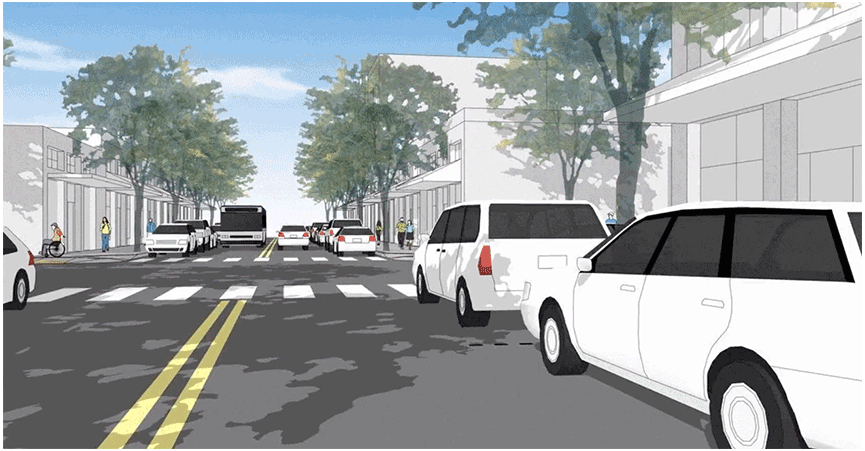
A nagging issue for traffic safety activists — intersection daylighting, where cars are prohibited from parking at corners — will see major progress thanks to funding pushed for by Transportation Commissioner Jo Ann Hardesty.
“Additional funding secured by Commissioner Hardesty is allowing PBOT to accelerate these changes on High Crash Network streets.”
— PBOT
This week the Portland Bureau of Transportation (PBOT) announced they plan to implement “vision clearance” at around 350 intersections and the work will be done by the end of June 2022. That’s a vastly accelerated timeline that comes as the City is embroiled in a lawsuit that says they aren’t following established guidelines.
Advocates had harangued PBOT for years to adhere to state law (ORS 811.550) that says people cannot park within 20-feet of crosswalks at an intersection. Portland City Code (16.20.130) states that parking is not allowed within 50 feet of an intersection under certain circumstances. The reason advocates care so much about this policy is because cars and trucks (especially large ones) block visibility of people trying to cross the street. Advocates also said PBOT rarely enforced the law. For their part, PBOT gave parking enforcement officers discretion and cited a part of the law that gives the “roadway authority” ability to interpret the guidance in a different way.
In September 2018 PBOT bent to community pressure and announced they’d start following the law; but only in very limited situations as part of new capital projects or alongside new developments. Also, as part of work to update the Pedestrian Master Plan, PBOT said they would require planners to set back parking at uncontrolled intersections (without stop signs or signals) on “pedestrian priority streets”. This included a limited number of intersections on neighborhood greenways and streets designated as city walkways or in specific Pedestrian Districts. PBOT said they’d also respond to individual complaints about specific locations.
Advertisement
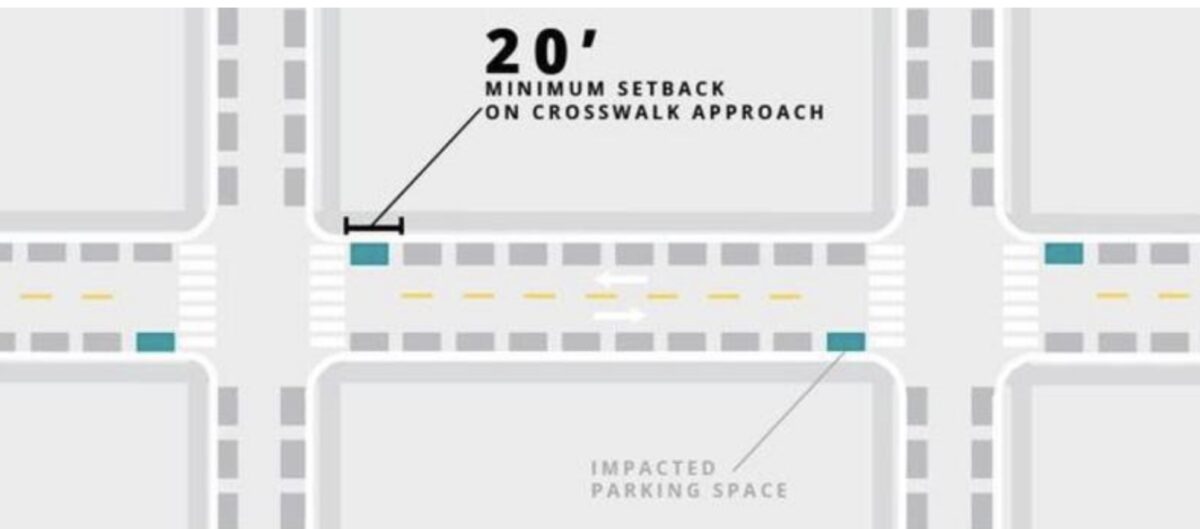
This approach left out thousands of dangerous intersections, so advocates kept pushing. In late 2019, nonprofit Oregon Walks launched a “clear the corners” campaign. Another pressure point was applied in February 2020 when a local law firm filed a lawsuit against PBOT claiming the lack of visibility at an intersection, and failure to comply with parking laws, led to the death of a motorcycle rider. That lawsuit is still working its way through the legal process.
In the meantime, PBOT Commissioner Hardesty has decided to push ahead with the policy as part of her “urgent response to the crisis of vehicular violence” via a budget amendment back in June that included $450,000 in funding for a suite of road safety measures.
PBOT announced Tuesday that $200,000 of that funding will go toward intersection vision clearance work. “PBOT typically applies vision clearance to streets only during paving and capital projects,” read a statement from PBOT. “Additional funding secured by Commissioner Hardesty is allowing PBOT to accelerate these changes on High Crash Network streets.”
This work will put even more strain on space for parking cars in Portland, which has been shrinking for years due to an increase in the number of drivers, a proliferation of street plazas and parklets in commercial districts, and other factors.
See more about PBOT’s daylighting policy here.



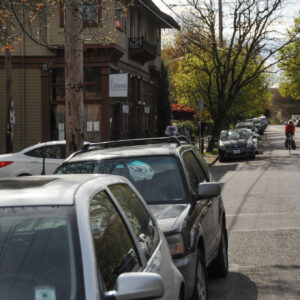
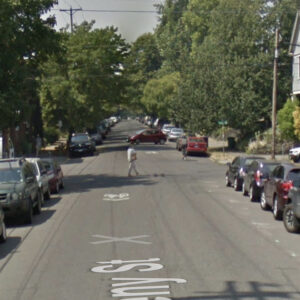
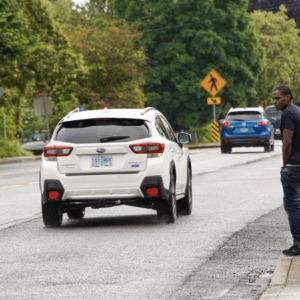
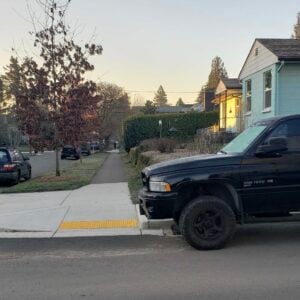
Thanks for reading.
BikePortland has served this community with independent community journalism since 2005. We rely on subscriptions from readers like you to survive. Your financial support is vital in keeping this valuable resource alive and well.
Please subscribe today to strengthen and expand our work.
Very welcome news. Should’ve been done a long time ago, but better late than never! Hopefully this will be done with widened sidewalks near the intersections, since we all know there’s no traffic enforcement.
Pepperidge farm remembers when local activists daylighted intersections according to the letter of state law and PBOT frittered away thousands of dollars by immediately sandblasting away the painted yellow curbs.
This is good news for pedestrian safety which needs all the help it can get…
Though I am concerned that the CoP will ‘fail’ given how much of a very heavy lift it is to reduce any on-street parking (or manage it better outside of paid parking meter zones) and get positive Vision Zero outcomes. In a year or two we may have to collectively revisit this initiative and consider the other solution: focusing on speed reduction and automated enforcement.
Sorry but we don’t need automated police , or speed traps. This sounds like you want to live in the book 1984
If you don’t break the law you won’t get a ticket.
Break the law, get your lovely picture taken and pay a fine.
What’s 1984 about that?
I’ve never been a fan of the red light or speed cameras, but after the last 1 1/2 years of near zero traffic enforcement we need something to stop the “Mad Max”ification of our streets.
I have this argument with my dad regularly – there is no expectation of privacy on a *public* street. Drive the speed limit and there’s no record of your passing – the picture is only snapped if you speed.
Or, reconfigure streets so they are narrower and less prone to speeding. The speed camera on BHH is there to catch people going over 35 on a road that is engineered for cars to go 50. If the roads weren’t open invitations to speed, there would be less places where enforcement of any kind would be needed.
Taking a picture of the license plates is not a problem. The problem is that the passengers facial recognition biometrics are also collected. The passenger would not be considered guilty in general because they were not driving.
The facial recognition systems make mistakes which increasingly result in dire consequences. People with false flags are increasingly being arrested, loosing jobs, being denied benefits, and much more. When the biometric data is stolen by a hack, which it will be, this automates identify theft. I had my identity stolen and it takes years and more money than I had for lawyers to clear most of it up. Identify theft rarely get fully cleared up, and can follow you for life.
Taking a picture of the license plates is not a problem. This is what the license plate is for. Automated blanket biometric data collection and fingerprinting of non-suspects is a major problem. Examples all over the world point to this as a game changing driver to making governments more authoritarian and less democratic.
So take a picture of the license plate only. Registered owner either pays the fine and gets points on their license. Or registered owner says who was actually driving the car and that person gets fine/points.
Except license plates are optional in lawless Portland.
That is a huge problem
City of Portland Parking Enforcement used to regularly write tickets for no front license plate. I don’t know if that’s still the case. But there is certainly not any ongoing effort to enforce the law outside of the heavily patrolled parking districts.
While that is a simple and logical solution, the State legislature would have to change the law to make that happen. I wouldn’t recommend holding your breath while you wait for them to act.
I’m almost certain no biometrics are used. They send the ticket and photo to the vehicle’s registered owner with the presumption it’s the owner driving it. If you go to court and show that you’re not the person in the photo, you’re cleared. And there’s no making you narc on who the driver actually was.
The photo that includes the face is by definition biometric source data. Fingerprinting of the source data can be done at any time in the future as long as the data is stored. There is no way of knowing who the company is sharing this data with, how long it will be stored, or what else it will be used for now or in future. This is because the surveillance industry is almost completely unregulated, with virtually no oversite or transparency. Once captured, biometric data likely exists indefinitely as surveillance companies have no benefit in deleting anything. The data is their future capitol.
There is a gold rush now by certain tech companies and startups to capture and store as much biometric source data as possible, for later monetization, such as for background check services to be used by employers and rental agencies. This all greatly accelerated since Claerview, and since then there has been a dramatic increase in how much of this data is hacked and stolen. Some Internet security experts are saying they have lost the battle as the rate of hacks greatly exceeds there ability to keep up. Biometric data that has not been stolen in a hack is almost becoming the exception. The only way to safeguard biometric data is to never collect it in the first place.
Wait till you hear about what they get on you when you get a license!
I’d like it if they didn’t allow enclosed street seating all the way up to the crosswalk like I see in several intersections around town. In some cases, these enclosures are opaque and over six feet tall as well.
Absolutely! Aztec Willie’s on NE Broadway and 15th is a horrible one.
My mind immediately jumped to that location when I read the previous comment. I’ve passed that enclosure dozens of times when traveling in the Broadway bike lane. Every time, I expect to get hit by a car traveling southbound on 15th. If that structure stays there permanently, I bet that corner will eventually pop up on the high crash network.
Ironically, I find this most annoying and dangerous as a driver rather than a cyclist because I drive a low car and have trouble seeing when the intersection is clear to drive across it. On a bike or motorcycle, I can stand up to see over the parked cars to insure a safe intersection crossing. So this isn’t just a pedestrian issue. I’m sure it will cut down on many car to car collisions as well. Insurance companies should welcome this. Why weren’t they advocating for it in the first place?
Indeed, this makes it more dangerous for drivers as well as pedestrians and bicyclists, because at a great many intersections, it’s only possible to see if it’s safe to turn (when in a car) by pulling into the (actual or implied) crosswalk space.
“…will see major progress thanks to funding pushed for by Transportation Commissioner Jo Ann Hardesty.”
I’ll believe it when I see it. And Jonathan good try in trying to put a positive spin on this for Hardesty. Give me a break. PBOT just succumbed to unrelenting pressure. Hardesty is the lead orchestrator for PBOT’s damaging “no enforcement” policies.
PBOT is not the police. Police is who should be doing enforcement.
Parking Enforcement is PBOT. They’d be the ones out writing parking tickets.
All those junked derelict cars you see all over are the responsibility of PBOT. Due to their enabling policies and lack of enforcement we have stolen cars littering our city.
Off topic. Junked cars are subject to tow on 72 hour notice, call it in.. If it’s a large vehicle blocking sight lines, same answer.
Except PBOT may not get to it for many months. Seriously.
they are not all stolen, some are bought at salvage auctions, stripped of useful parts and then abandoned in the ROW.
PBOT needs to daylight intersections by physically blocking off areas with bike corrals and concrete barriers for street plaza type installations.
Yes… but then the trucks go and run them over making poor turns. I remember one corral (off Division or Clinton?) that seemed to get run over every week.
Re “Portland’s parking supply… has been shrinking for years due to increased residential and commercial development”
This is wrong. You could rephrase it to correctly say that the surplus, unused amount of street parking has decreased. But since most new residential and commercial buildings add new parking spaces as part of the development, the total number of parking spaces has been increasing every year in the city. It’s just not increasing as quickly as the number of motor vehicles (well I assume so? Perhaps this should be confirmed first? Maybe it’s only in some neighborhoods?)
Thanks Joseph. I’ve reworded that section.
This has been one of those things that had caused me more close encounters than pretty much any other traffic issue over the years. About time, but exciting. Get it done!
Just nitpicking a bit at the language in this article and PBOT press release. They’re not daylighting 350 uncontrolled intersections. They’re daylighting uncontrolled approaches at intersections that are either uncontrolled or two way stop controlled. PBOT also was pretty responsive to a previous request I made along Flanders when it was installed to daylight a stop controlled approach.
This is a good and modest first step, but I’m not sure why in the map above all spots near all crosswalks aren’t blocked out. Cars routinely block the curb cuts. When it’s a giant pickup/SUV, it makes it hard for pedestrians to see.
And for those in wheelchairs to use the curb cut to cross the street.
One of my pet peeves.
I sent PBOT a letter in 2018 asking them why they disregard state law and allow parking within 20 feet of a crosswalk, which is essentially every intersection. The reply I got back from them basically stated, “because we can,” quoting the state law that allows municipalities to make their own parking laws.
I had suggested that allowing parking at intersections was dangerous and inconvenient for all road users, citing personal examples from my own experiences as a driver, cyclist, and pedestrian.
Clearly the city values storage of private property on our rights of way over the safety of our citizens.
All this talking and appropriating when all they need to do is enforce existing law.
I welcome this. But I have questions:
Are they just daylighting to the letter of the Oregon law (20′), or Portland’s (50’+height restriction)? The graphic implies, unfortunately, the former.
NW Portland recently got a number of intersection daylights, particularly along NW 20th as it crosses Lovejoy and Northrup, but they’re basically next to useless – I doubt they’re actually 20′, and there’s almost always a giant van or truck parked right at the edge of the daylight zone, completely blocking all visibility anyway. And as others have stated, this is arguably more an issue for vehicles that extend past eyeballs (bikes, cars, motorcycles, etc) than peds, but regardless it’s a problem for everyone.
I hope that this becomes an annually reauthorized program. 350 intersections is a great start. But we’ll have thousands more to go. Much like the Ada curb cut program, we should be aiming to retrofit every intersection eventually. And we shouldn’t be waiting for capital improvement projects to make changes. It’s better to physically block areas and prevent parking near corners, but no parking signs are a good first step that is relatively cheap to implement.
it would be better and even a revenue generator (tickets) to just enforce existing parking laws. No Parking sign $60, pole to mount it on $50, plate and hardware to attach it $45 PBOT crew to install 1 sign $900.00
I literally laughed out loud as I read this because I had a conversation about this with Hardesty’s policy person in May and he told me if we did this there wouldn’t be enough parking. This actually happening sounds more like someone at PBOT pushing for it and not at all the Commissioner’s office.
I have a complaint about the dumpster on 2nd ave downtown by the world trade center, its been there for a year and it is right on the crosswalk line.
This was one of the most shocking things when I moved to Portland… you literally CANNOT SEE anything when you get to some of these intersections. If 4-way stops existed it’d help, but that was shocker #2. If driving, sometimes I just roll slowly so at least vulnerable road users have a chance.
To round it out the complete lack of lighting at night was #3… I’m all for LED and dark skies, but 0 viz is dangerous, I have to carry a flashlight if I walk at night (under the streetlights!).